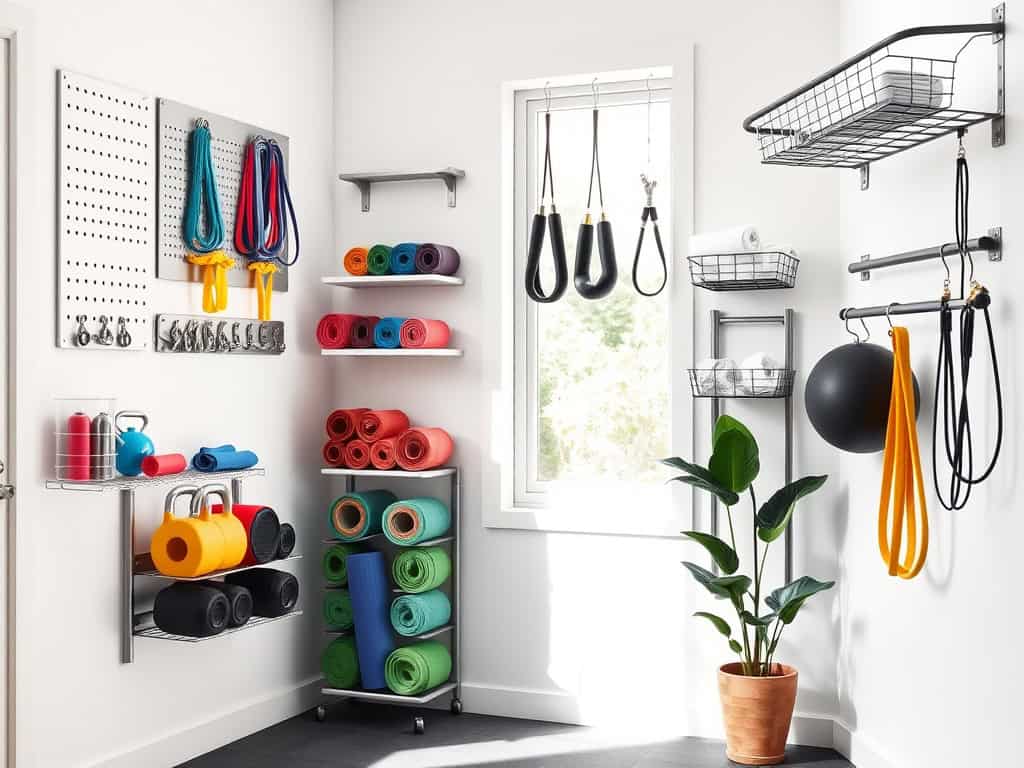Did you know that the average home gym enthusiast wastes up to 30% of their workout space due to poor storage solutions? As someone who’s transformed countless cluttered fitness areas into organized training havens, I’ll share nine clever storage ideas that’ll revolutionize your home gym setup. Whether you’re working with a dedicated room or a corner of your garage, these space-saving techniques will help you create a well-organized fitness sanctuary that’ll keep you motivated and moving efficiently.
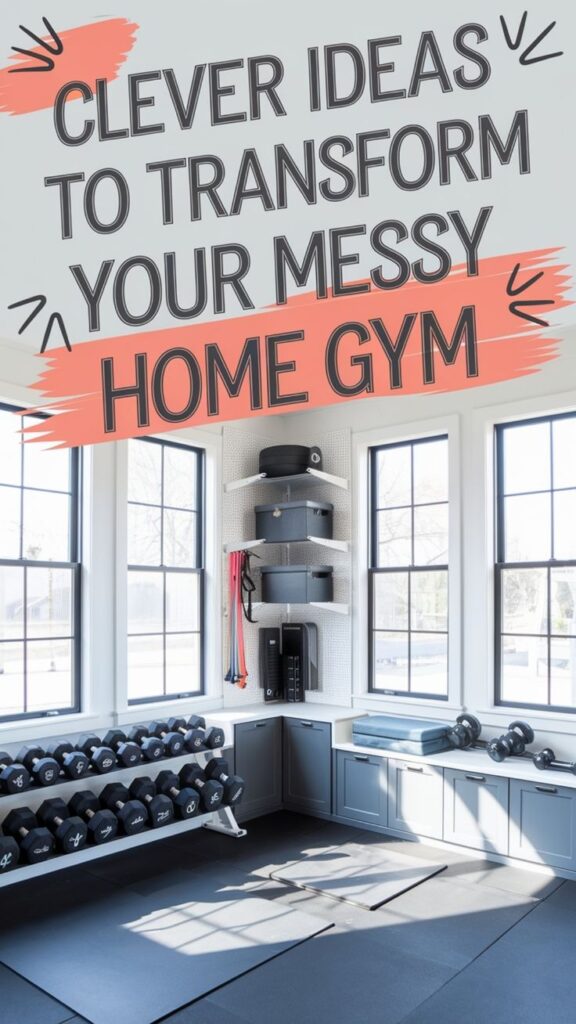
Vertical Wall-Mounted Storage Racks
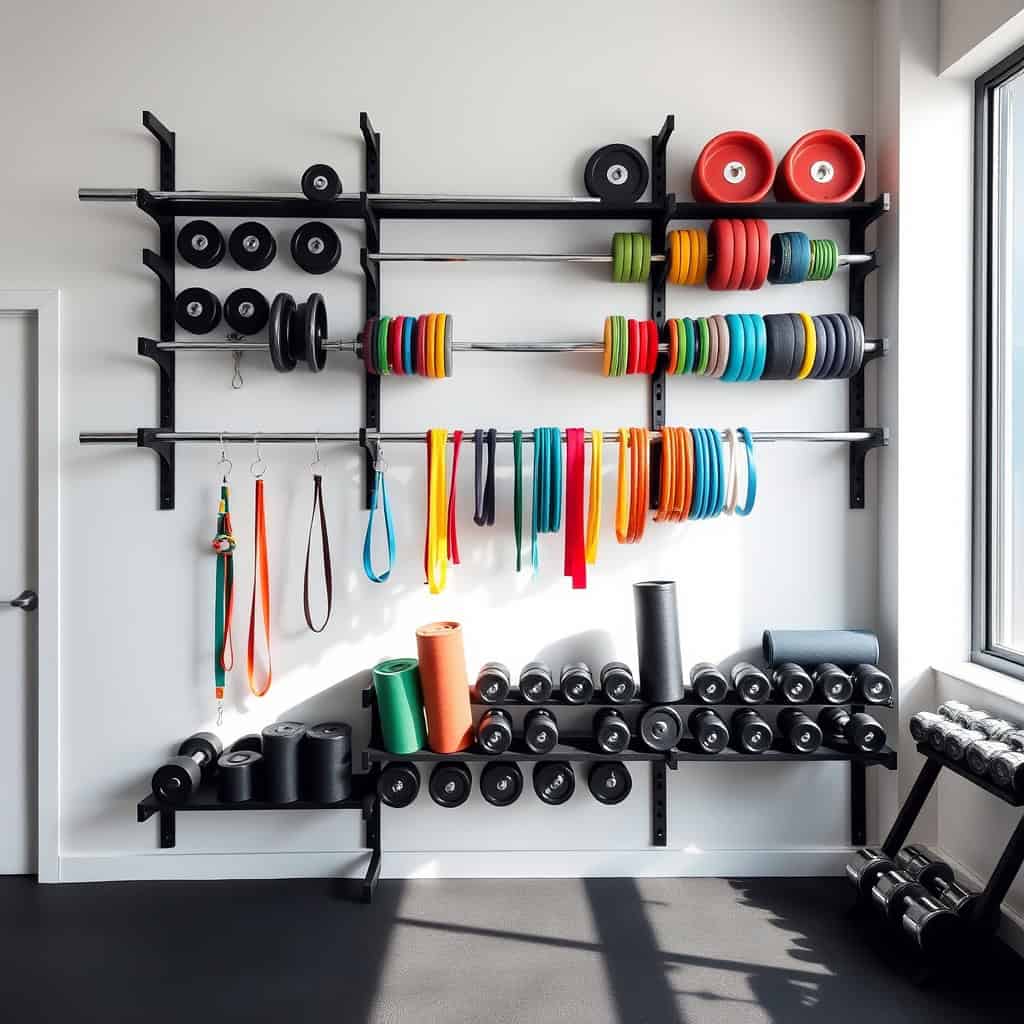
Maximizing vertical space in a home gym is crucial for creating an efficient and inviting workout environment. Wall-mounted storage racks not only free up valuable floor space but also make equipment easily accessible while adding a professional, organized appearance to your workout area.
Proper vertical storage organization can significantly impact your workout routine by reducing setup time and preventing accidents caused by scattered equipment. When weights, bars, and accessories are systematically arranged on the wall, you can quickly transition between exercises and maintain a clean, motivating space.
Required Items:
- Heavy-duty wall brackets
- Wall anchors and mounting hardware
- Measuring tape
- Level
- Power drill
- Pencil
- Stud finder
- Weight-rated storage hooks
- Wall-mounted rack systems
- Safety straps or brackets
- Cleaning supplies
Installing vertical wall-mounted storage starts with identifying weight-bearing walls using a stud finder. Mount the main support brackets at appropriate heights, ensuring they’re level and securely anchored into wall studs.
Space multiple brackets evenly to distribute weight and accommodate different equipment sizes. Install specialized hooks and holders based on your specific equipment needs, such as barbell holders, weight plate pegs, and accessory hooks.
Consider organizing equipment by frequency of use, with regularly used items at eye level and less frequently used items higher up. Group similar items together, such as keeping all resistance bands in one section and weight plates in another.
Ensure adequate spacing between items to prevent overcrowding and allow easy access.
Additional Tips: Label storage zones to maintain organization and regularly inspect mounting hardware for security. Consider installing rubber backing or protective wall panels to prevent wall damage from equipment contact.
Keep a small step stool nearby for safely accessing items stored at higher levels, and always follow weight capacity guidelines for your mounting systems to ensure long-term stability and safety.
Multi-Purpose Storage Benches and Ottomans
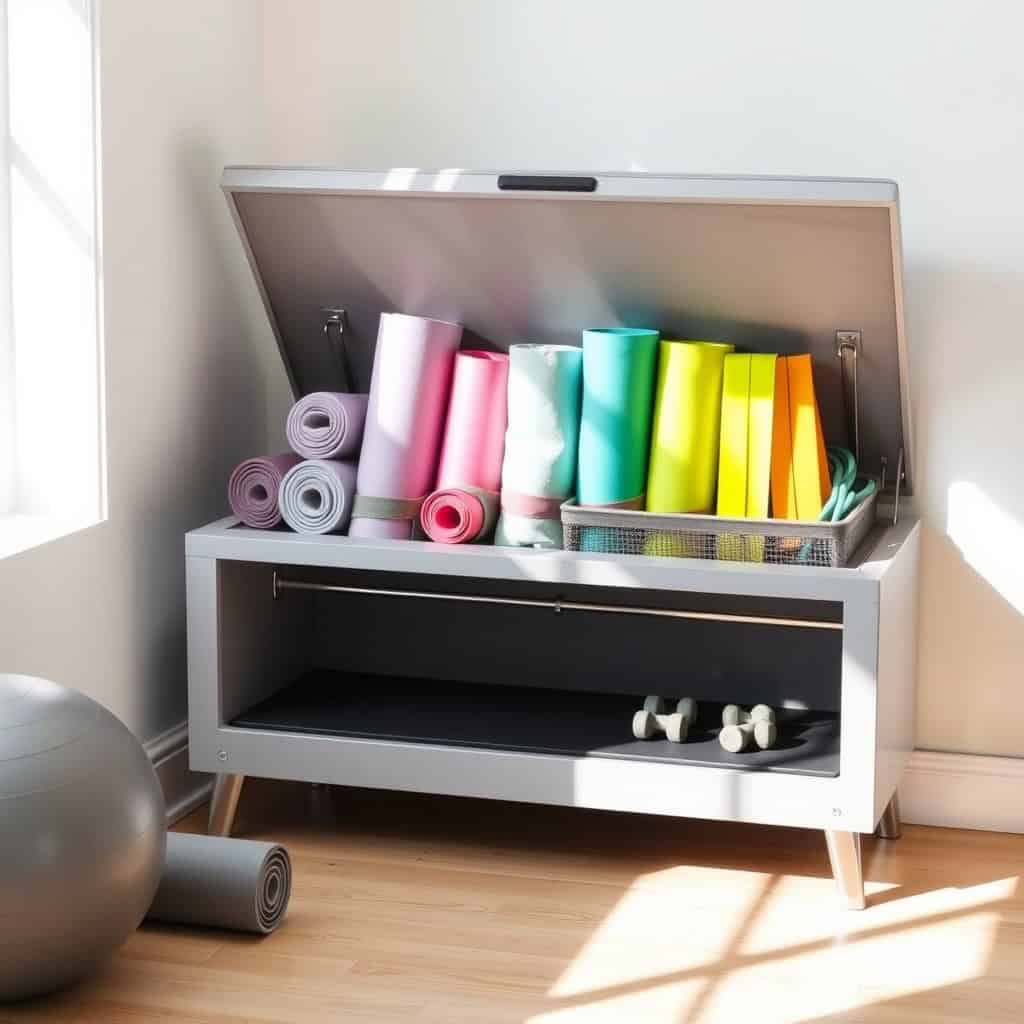
Multi-purpose storage benches and ottomans are essential solutions for home gym organization, combining functionality with space efficiency.
These versatile pieces serve as seating, storage, and sometimes even as workout surfaces, making them invaluable for compact home gym setups.
Maximizing the potential of storage benches and ottomans can transform a cluttered workout space into an organized fitness sanctuary.
When properly utilized, these pieces can house everything from resistance bands and yoga mats to small weights and workout accessories, while maintaining easy access and a clean aesthetic.
Required Items:
- Storage bench or ottoman with lid
- Storage dividers or bins
- Label maker
- Drawer liner or rubber matting
- Clear storage containers
- Mesh bags
- Tension rods (for vertical organization)
- Hook-and-loop fasteners
- Small bins or baskets
Start by categorizing gym equipment based on frequency of use and type of exercise.
Place frequently used items in easily accessible areas of the bench or ottoman.
Install drawer liner or rubber matting at the bottom to prevent items from sliding and protect the interior.
Utilize storage dividers to create designated spaces for different categories of equipment, such as resistance bands, weights, or recovery tools.
For vertical organization within deeper storage benches, install tension rods to create levels, allowing for better utilization of space.
Use mesh bags or clear containers to group similar items together, such as keeping all yoga accessories in one container or resistance bands in a single mesh bag.
Attach hook-and-loop fasteners to the interior walls to secure lighter items like jump ropes or resistance bands.
To maintain organization and extend the life of your storage solution, regularly assess the contents and adjust the organization system as needed.
Keep heavy items at the bottom of storage benches to maintain stability, use labels to identify contents quickly, and consider implementing a seasonal rotation system for equipment that isn’t used year-round.
Periodically clean both the interior and exterior of the storage piece to prevent dust accumulation and maintain a hygienic workout environment.
Corner Shelf Systems for Equipment Organization
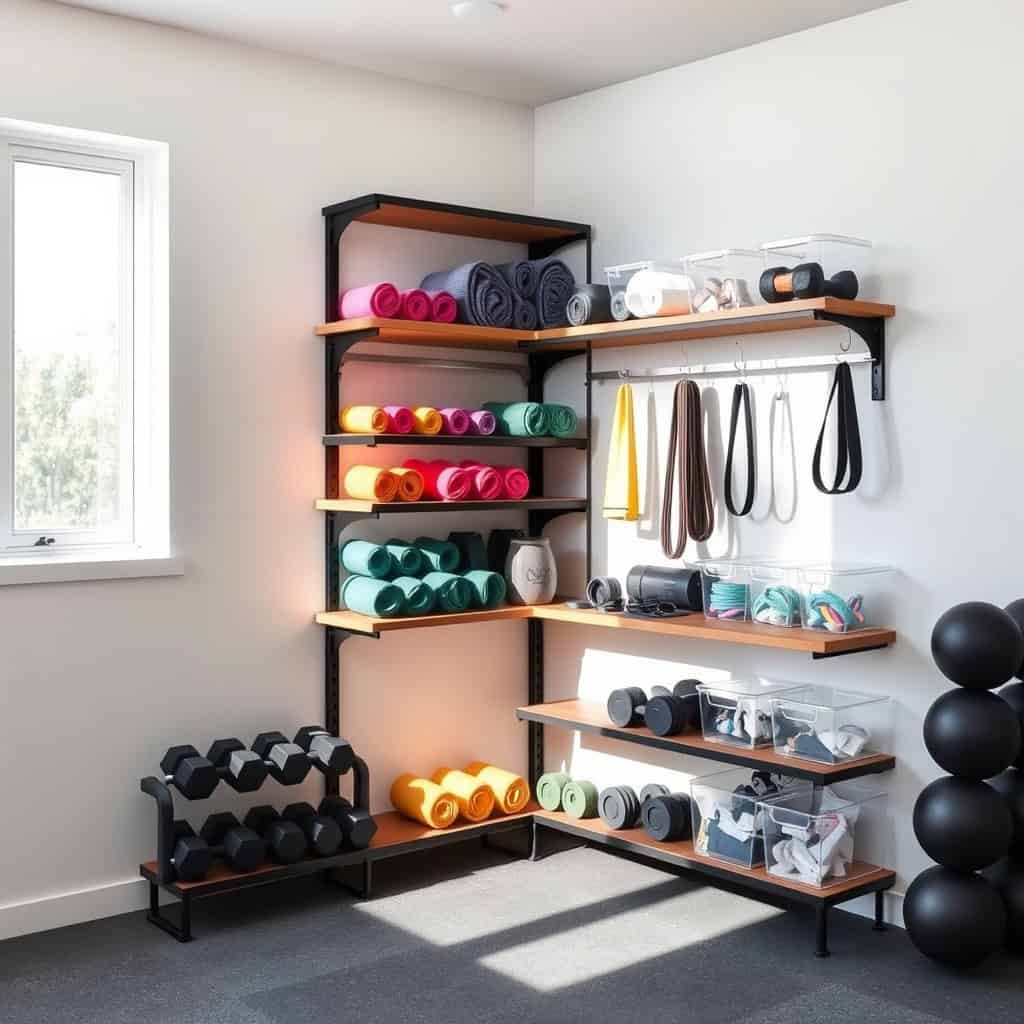
Creating an organized corner shelf system in your home gym is crucial for maximizing limited space while keeping equipment easily accessible. A well-planned corner storage solution can transform an underutilized area into a functional storage hub that maintains the flow and safety of your workout space.
Strategic corner organization not only helps prevent equipment damage and extends its lifespan but also creates a motivating environment that encourages regular exercise. When weights, resistance bands, and other fitness tools are properly displayed and within reach, workouts become more efficient and enjoyable.
Required Items:
- Corner shelf unit (adjustable or fixed)
- Wall anchors and mounting hardware
- Level
- Drill
- Measuring tape
- Pencil
- Storage bins or baskets
- Equipment hooks
- Label maker or labels
- Safety straps
- Rubber shelf liners
Start by measuring your corner space and selecting an appropriate shelf system that accommodates your ceiling height and equipment dimensions. Install the corner unit by marking mounting points, drilling pilot holes, and securing the structure with appropriate wall anchors.
Ensure the unit is level and stable before loading any equipment. Arrange equipment by frequency of use, with regularly used items at eye level and heavier items on lower shelves. Implement zones for different types of equipment: weights on bottom shelves, resistance bands on hooks, and smaller accessories in labeled bins.
Use rubber shelf liners to prevent equipment from sliding and protect shelf surfaces.
Additional Organization Tips:
Consider installing LED strip lighting to illuminate dark corners and make equipment more visible. Use clear storage bins to easily identify contents, and implement a regular maintenance schedule to ensure the system remains organized.
Keep a small stepstool nearby for safely accessing items on higher shelves, and periodically review your organization system to adapt to changing workout needs or new equipment acquisitions.
Rolling Storage Carts and Mobile Solutions
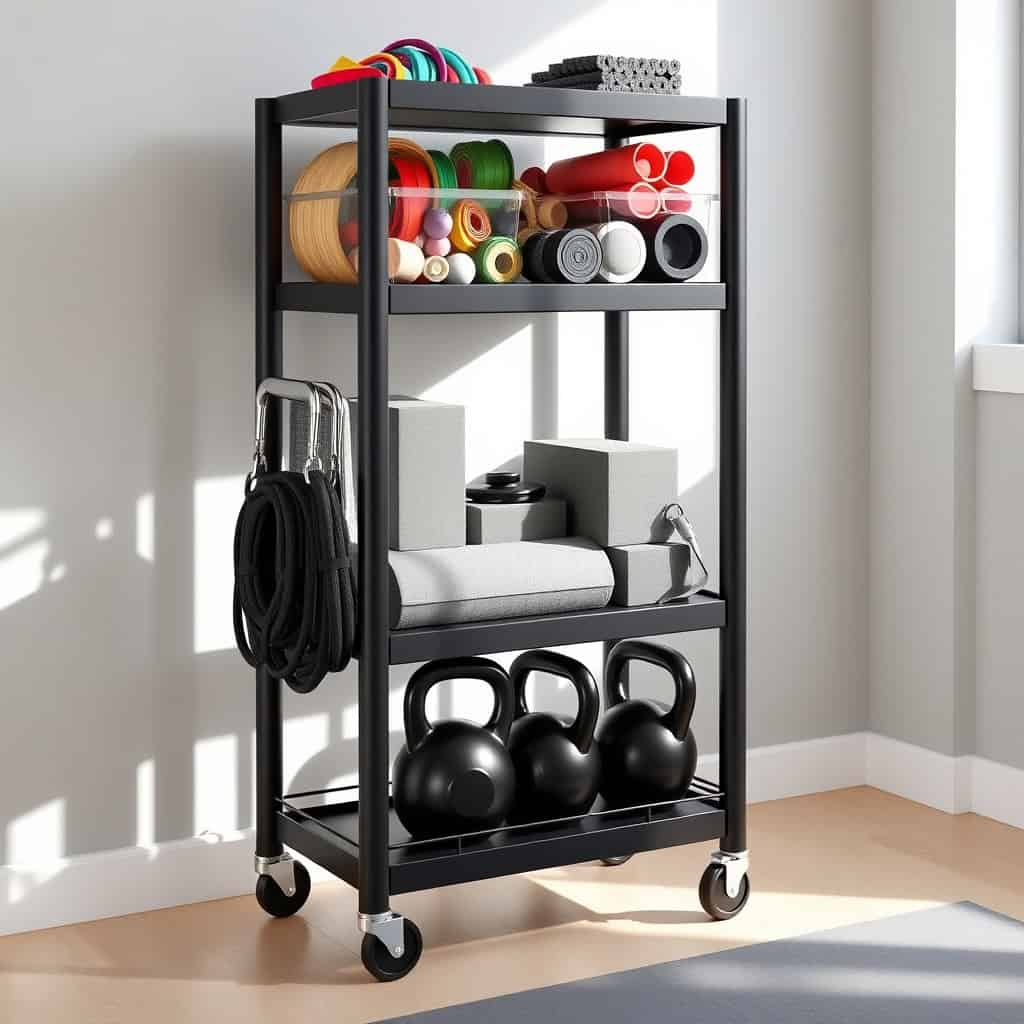
The integration of mobile storage solutions in a home gym transforms a static workout space into a dynamic, adaptable environment. Rolling storage carts allow for seamless transitions between different workout zones while keeping equipment organized and readily accessible, maximizing both space efficiency and workout flow.
Mobile storage solutions are particularly valuable for home gyms with limited space or those that share space with other room functions. The ability to wheel equipment in and out of the workout area provides flexibility while ensuring every piece of equipment has a designated storage spot when not in use.
Required Items:
- Multi-tier utility cart
- Storage bins or containers
- Label maker
- Bungee cords or straps
- Rubber mat liners
- Wheels with locks
- Storage basket hooks
- Clear storage containers
- Mesh bags
- Cleaning supplies
Start by categorizing your equipment based on frequency of use and workout type. Designate specific tiers or sections of your rolling cart for different categories: resistance bands and small weights on top, medium-weight equipment in the middle, and heavier items on the bottom for stability.
Install rubber mat liners on each shelf to prevent items from sliding during movement. Secure items that might shift using bungee cords or containment barriers.
Implement a zone system by assigning each cart to specific workout types. For example, one cart for cardio accessories, another for strength training equipment, and a third for recovery tools.
Install hooks on the sides of carts to maximize vertical storage space and accommodate items like resistance bands or jump ropes. Ensure all carts have wheel locks to prevent unwanted movement during exercise.
Additional Tips: Consider using clear storage containers on cart shelves to maintain visibility while keeping items contained. Create a cart parking map to designate specific locations where each cart should return after use.
Regular maintenance of wheel mechanisms and periodic reorganization of contents will ensure long-term functionality and prevent clutter accumulation. Keep frequently used items at arm’s level for quick access during workouts.
Pegboard Wall Systems for Hanging Gear
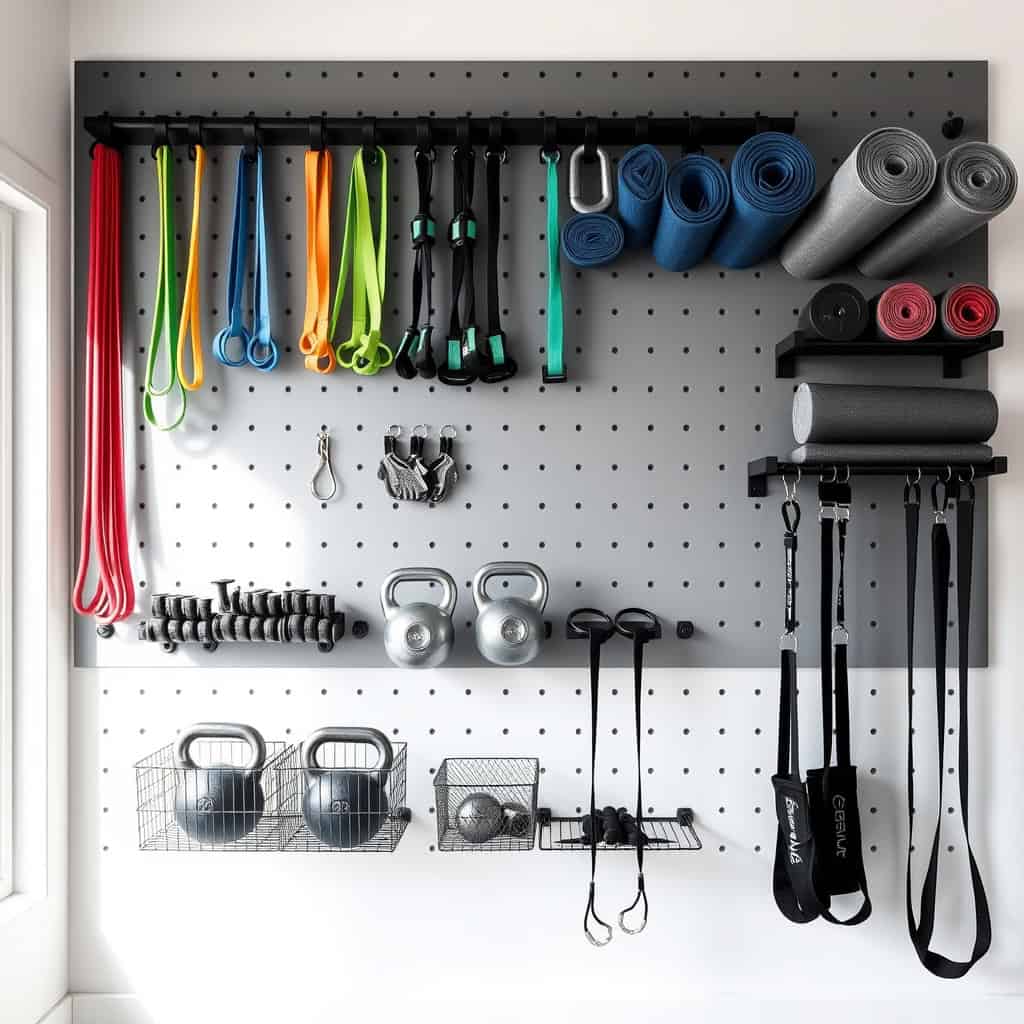
A well-organized home gym maximizes workout efficiency and motivation by keeping equipment easily accessible and visible. When exercise gear is properly stored and displayed, it not only creates an inviting workout space but also helps protect and maintain valuable fitness equipment.
Pegboard wall systems represent one of the most versatile and space-efficient storage solutions for home gyms. These customizable systems allow for frequent reorganization as your fitness needs evolve, while keeping floor space clear and equipment within arm’s reach during workouts.
Required Items:
- Pegboard panels
- Wall mounting brackets
- Drill and screws
- Stud finder
- Level
- Pencil
- Measuring tape
- Various pegboard hooks and holders
- Wire baskets
- Tool holders
- Safety equipment (goggles, gloves)
Installation and organization begins with locating wall studs and marking their positions. Mount the pegboard brackets securely to the studs, ensuring the board sits approximately one inch from the wall to accommodate hooks.
Once the pegboard is mounted, create zones for different equipment types: resistance bands at eye level, lightweight items like jump ropes higher up, and heavier items at waist height or lower.
Arrange equipment by frequency of use, keeping regularly used items in the most accessible locations. Install various hook types and holders based on equipment needs – J-hooks for resistance bands, straight pegs for rolled yoga mats, and wire baskets for smaller items like weight clips or exercise gloves.
Consider adding labels or using color-coded zones to maintain organization. For optimal organization longevity, regularly assess the layout and adjust as needed.
Install weight limits on hooks, use rubber-coated options for metal equipment to prevent scratching, and maintain some empty space for future additions. Consider adding a small whiteboard or clipboard to track equipment maintenance or workout schedules, maximizing the functionality of your pegboard system.
Under-Bed Storage Solutions for Small Spaces
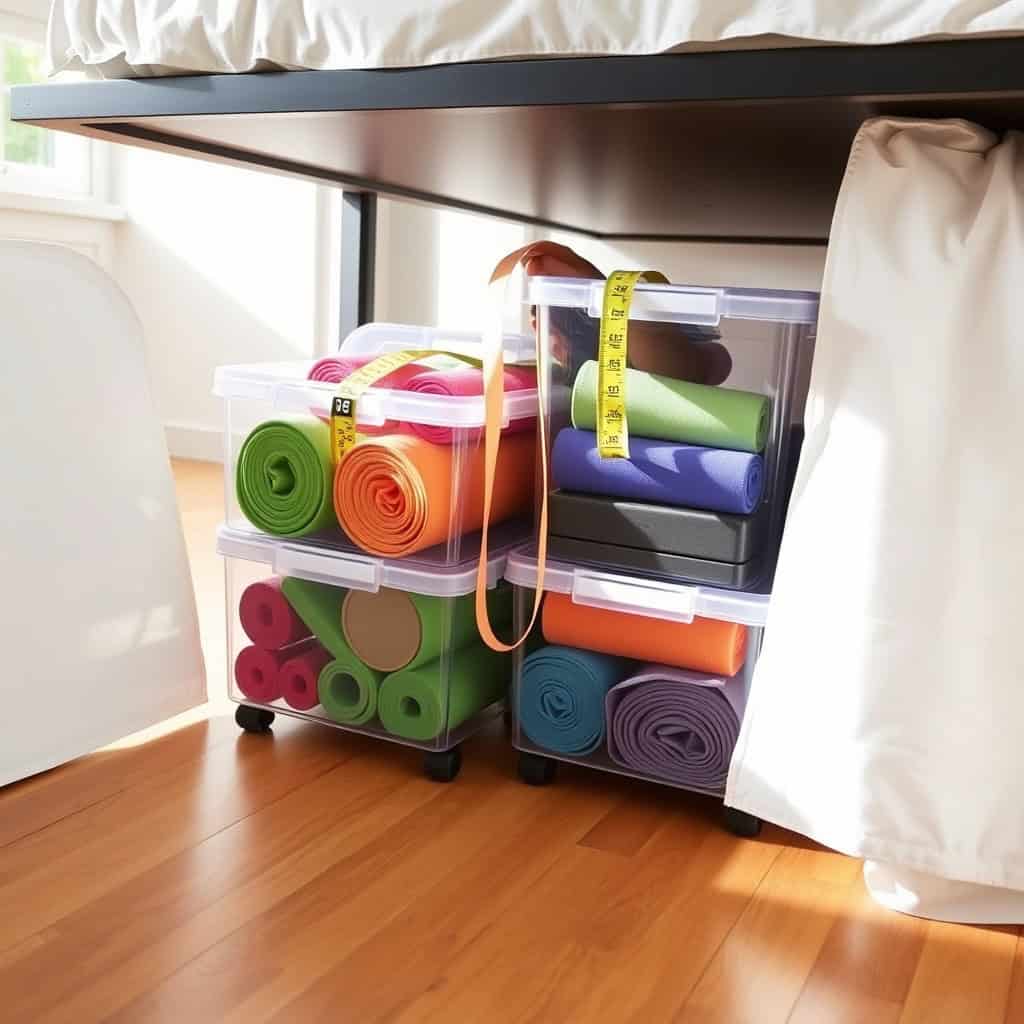
Making the most of under-bed space is crucial for home gym enthusiasts working with limited square footage. This often-overlooked storage area can accommodate various pieces of exercise equipment, from yoga mats to resistance bands, while keeping them easily accessible and protected from dust.
Proper under-bed storage organization not only maximizes available space but also helps maintain equipment longevity and creates a clutter-free workout environment. When exercise gear is properly stored and easily retrievable, you’re more likely to maintain consistent workout habits and protect your fitness investment.
Required Items:
- Under-bed storage containers with wheels
- Measuring tape
- Labels
- Vacuum storage bags
- Dust-proof covers
- Clear plastic bins
- Drawer dividers
- Bed risers (if needed)
- Anti-moisture packets
- Cleaning supplies
Start by measuring the available space under your bed, including height, width, and depth. Clear the area completely and clean thoroughly to remove dust and debris. Select appropriate storage containers that maximize the available space while allowing easy access – wheeled containers are ideal for heavier equipment.
Sort exercise equipment by frequency of use and type. Place frequently used items like resistance bands and yoga mats in easily accessible containers near the foot or side of the bed. Store seasonal or less-used equipment toward the head of the bed. Use vacuum storage bags for compressible items such as exercise towels or workout clothes.
For optimal organization, implement a zone system: designate specific areas under the bed for different categories of equipment. For example, create zones for cardio accessories, strength training equipment, and recovery tools. Label each container clearly on both the top and sides for easy identification without pulling everything out.
Additional Tips: Consider installing bed risers to create extra storage height if needed. Place anti-moisture packets in containers to prevent equipment degradation, especially in humid environments.
Create a detailed inventory list of stored items and their locations, and review the organization system quarterly to ensure it continues to meet your needs. Always leave a small gap between containers for air circulation to prevent moisture buildup.
Door-Mounted Storage and Hooks
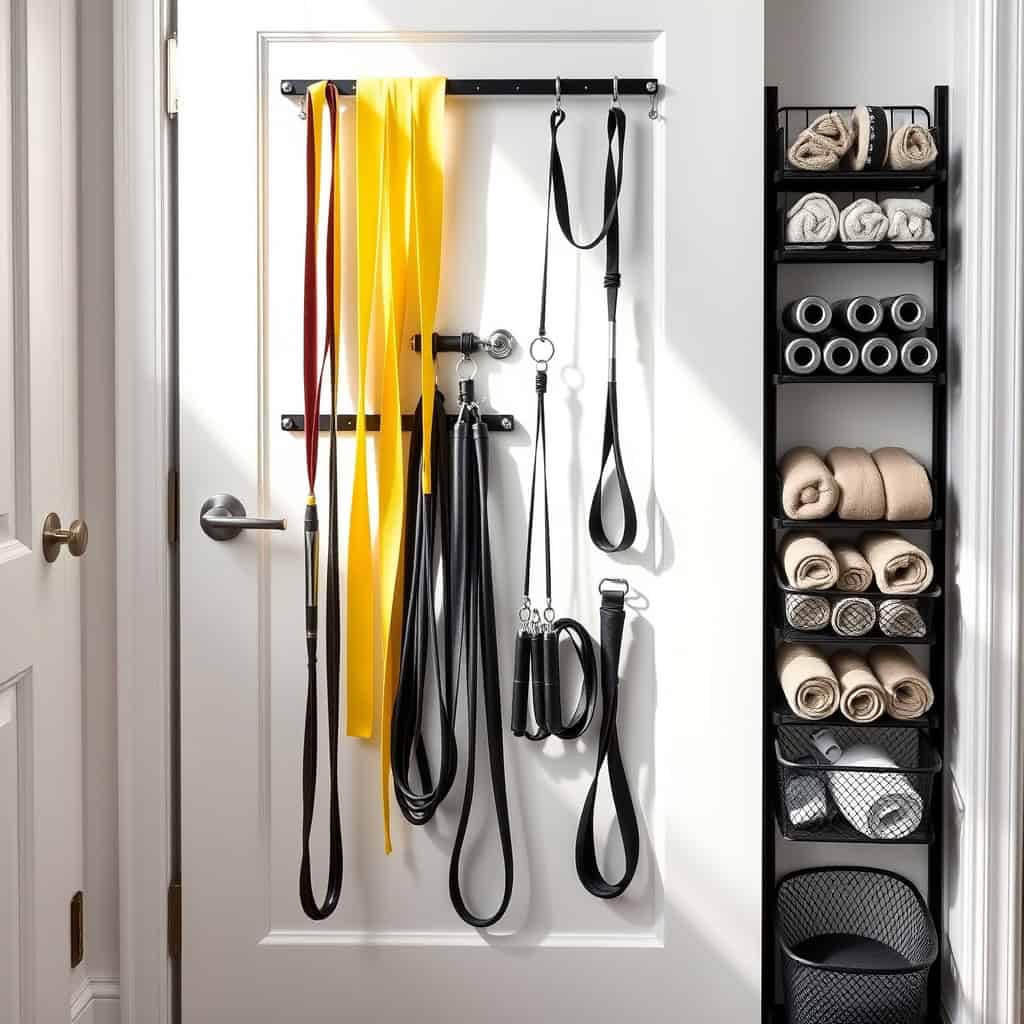
Maximizing vertical space in a home gym is crucial for maintaining an organized and efficient workout environment. Door-mounted storage solutions offer an often-overlooked opportunity to utilize otherwise wasted space while keeping equipment easily accessible and off the floor.
Door-mounted storage systems are particularly valuable for smaller home gyms where floor space is at a premium. These solutions can accommodate a variety of equipment, from resistance bands and jump ropes to yoga mats and lightweight dumbbells, making them an essential component of any well-organized fitness space.
Required Items:
- Over-the-door hooks
- Door-mounted rack system
- Heavy-duty mounting brackets
- Screws and anchors
- Power drill
- Level
- Measuring tape
- Pencil
- Storage baskets or bins
- Resistance band hooks
- Weight-rated door hooks
Start by measuring your door’s dimensions and marking the optimal height for different types of equipment. Install the main door-mounted rack system according to manufacturer specifications, ensuring it’s level and secure. Most systems require drilling into the door frame or attaching over the top of the door.
Position hooks at varying heights to accommodate different equipment lengths and sizes. For over-the-door solutions, place the hooks at the top of the door, ensuring they’re firmly seated and won’t shift during use. Install additional individual hooks at strategic points for items like resistance bands, jump ropes, and towels.
If using a basket system, secure these to the rack or hooks, making sure they’re positioned at easily accessible heights. When organizing equipment on the door storage system, group similar items together and place frequently used items at eye level.
Position heavier items closer to the bottom of the door for stability, and ensure all mounted components are well within their weight capacity ratings. Consider adding labels to baskets or designated areas to maintain organization long-term.
Additional Tips:
To maximize door-mounted storage effectiveness, regularly inspect all mounting hardware and tighten as needed. Use rubber or foam padding on hooks to prevent equipment damage, and consider installing a door stopper to prevent the door from hitting the wall when weighted with equipment.
Always verify your door’s construction can support the intended weight load, and avoid overloading any single hook or bracket beyond its rated capacity.
Decorative Storage Baskets and Bins
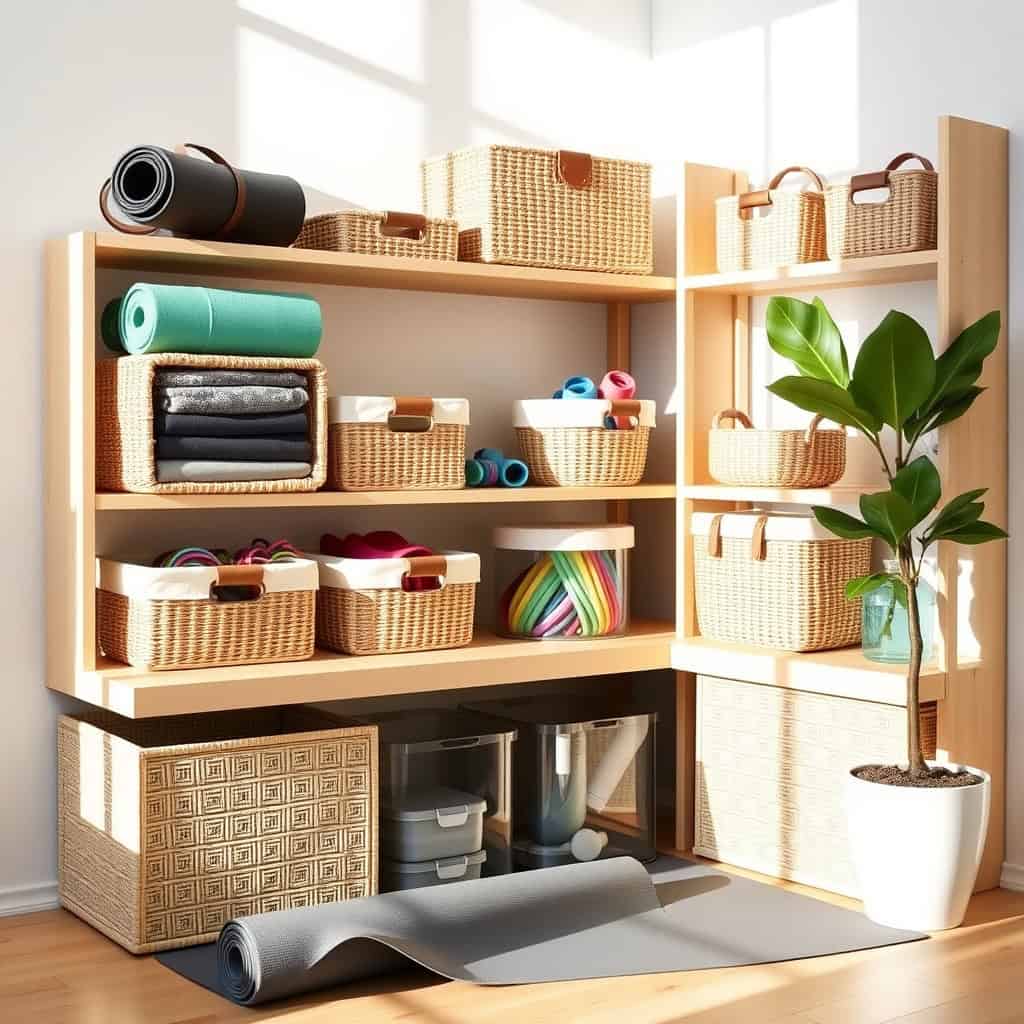
Organizing fitness equipment with decorative storage baskets and bins transforms a cluttered home gym into an inviting, efficient workout space. Well-chosen containers not only keep equipment organized but also contribute to the room’s aesthetic, making it more appealing and motivating to use regularly.
Strategic basket and bin organization helps maintain proper equipment care, extends gear lifespan, and ensures quick access during workouts. When items have designated homes, you spend less time searching and more time exercising, leading to more productive training sessions.
Required Items:
- Assorted decorative storage baskets
- Clear plastic bins
- Label maker or tags
- Shelf liner or non-slip mats
- Measuring tape
- Container dividers
- Storage bench (optional)
- Wall-mounted basket holders
- Moisture-resistant containers
- Cleaning supplies
Start by categorizing your gym equipment by type, size, and frequency of use. Designate large, sturdy baskets for heavy items like weights and resistance bands, while utilizing smaller containers for accessories like exercise clips and gloves. Select moisture-resistant materials for items that may get sweaty, and clear bins for items you need to identify quickly.
Position the storage solutions strategically around your workout space. Place frequently used items at eye level in easily accessible baskets, while storing seasonal or rarely used equipment in higher or lower positions. Install wall-mounted basket holders to maximize vertical space and keep floor areas clear for exercise.
Additional Organization Tips: Implement a color-coding system for different equipment categories, and use basket liners to protect both the containers and equipment. Regularly audit stored items, removing anything that hasn’t been used in six months.
Consider installing a pegboard above your storage area for hanging resistance bands and jump ropes, keeping them visible and preventing tangling in baskets.
Hidden Cabinet and Drawer Solutions
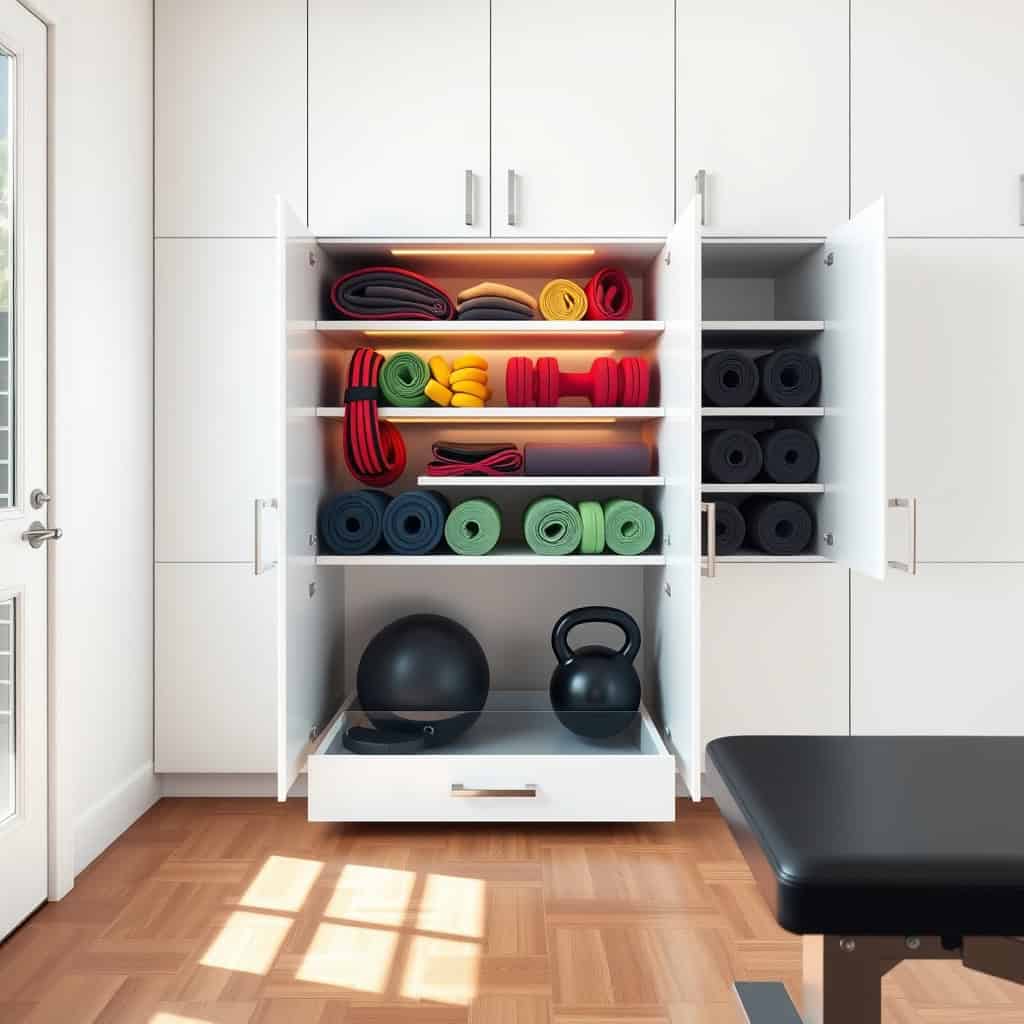
Creating concealed storage solutions in your home gym transforms a cluttered workout space into a sleek, organized environment that motivates and inspires. Hidden cabinets and drawers not only maintain the aesthetic appeal of your gym but also protect valuable equipment from dust and damage while maximizing available space.
Strategic cabinet and drawer placement allows you to categorize equipment by workout type, frequency of use, and size, making your exercise routine more efficient and enjoyable. These hidden storage solutions can be incorporated into walls, under benches, or within existing furniture to maintain a clean, professional appearance while keeping everything within arm’s reach.
Required Items:
- Cabinet hardware (hinges, handles, slides)
- Plywood or MDF boards
- Measuring tape
- Power drill
- Screwdriver set
- Level
- Wood screws
- Cabinet organizers
- Labels
- Drawer dividers
- Cabinet door stoppers
- Mounting brackets
Start by measuring your available wall space and equipment dimensions to determine optimal cabinet and drawer sizes. Install wall-mounted cabinets at comfortable reaching height, using sturdy mounting brackets and ensuring they’re properly leveled.
For drawer installations, focus on areas under benches or existing structures, installing drawer slides that can support the weight of your equipment. Create designated zones within cabinets and drawers using dividers and organizers. Arrange smaller items like resistance bands and hand weights in drawers, while larger equipment can be stored in cabinets.
Install hooks on cabinet doors’ interior surfaces for hanging resistance bands or jump ropes. Consider adding soft-close mechanisms to prevent slamming and protect both the storage solutions and equipment.
Additional Tips: Incorporate moisture-resistant materials in areas where sweaty equipment will be stored, and add silica gel packets to prevent humidity buildup. Install LED strip lighting inside cabinets for better visibility, and use clear containers or labels to quickly identify contents.
Regularly review and adjust your organization system to ensure it continues meeting your evolving fitness needs and equipment collection.

